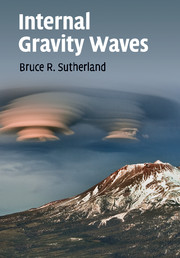5 - Generation mechanisms
Published online by Cambridge University Press: 05 October 2014
Summary
Introduction
In this chapter we examine the various mechanisms through which interfacial waves and internal waves can be created. Broadly speaking, the waves can be generated either by solid bodies or by disturbances within the fluid such as convection, imbalance of large-scale flows, gravity currents and turbulence. Here we focus upon generation by solid bodies, the theory for which is better established.
In a uniformly stratified fluid, we have already seen that an oscillating body creates a cross-shaped pattern of waves. Here, we study this problem in more detail by examining the structure of the wave beams that emanate from a vertically oscillating cylinder and sphere. Although this mechanism has little bearing on geophysical flows, it is amenable to study in laboratory experiments which can test the limitations of theory applied to this seemingly simple circumstance.
More realistic is the study of uniform and tidal flow over topography. This subject has been well studied in theory and by way of experiments, and the results have been compared with ample observational data. Because much of this work is discussed elsewhere, only the salient points will be presented here.
Oscillating bodies
In Section 3.3 we saw that any body oscillating with frequency ω in uniformly stratified fluid with buoyancy frequency N0 creates a cross-shaped pattern of internal waves if ω < N0. Here we examine how the structure of the wave beams is affected by the shape of the body in two and three dimensions.
- Type
- Chapter
- Information
- Internal Gravity Waves , pp. 262 - 314Publisher: Cambridge University PressPrint publication year: 2010



